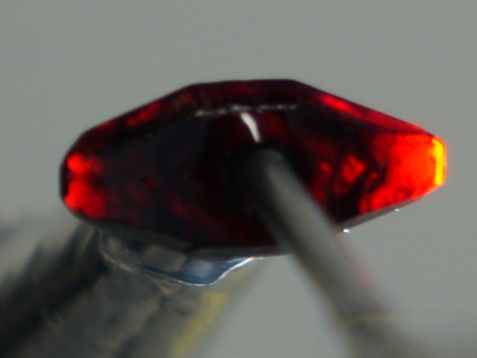MLZ is a cooperation between:
 > Technische Universität München
> Technische Universität München > Helmholtz-Zentrum Hereon
> Helmholtz-Zentrum Hereon
 > Forschungszentrum Jülich
> Forschungszentrum Jülich
MLZ is a member of:
 > LENS
> LENS > ERF-AISBL
> ERF-AISBL
MLZ on social media:

MLZ (eng)
Lichtenbergstr.1
85748 Garching
21.12.2017
With angelic patience to the pure atomic arrangement

The purely left-handed crystal was cultivated by the Japanese scientist in centimeter size. © V. Hutanu / MLZ
CsCuCl3 crystallizes in a right and left form. Under normal conditions, it is impossible to separate these two so-called chiral forms and to obtain a crystal with a purely right or purely left atomic arrangement. The Japanese scientist Dr. Yusuke Kousaka has not only managed to grow pure monochiral crystals, but also to prove the direct correlation between crystalline and magnetic chirality with polarized neutrons at the single-crystal diffractometer POLI.
Chiral structures occur in nature in all magnitudes from subatomic to galaxies. Having the heart in the right place is only correct, if you look in the mirror, because in reality it is on the left side. These mirror-inverted structures are called chiral, derived from the Greek word for “hand”. Chirality therefore means that the right and the left hand can only be matched by mirroring.
Chemical chirality vs magnetic chirality
One might think it is left to chance, if a chain of atoms or molecules turns to the right or to the left and it does not matter for their physical or chemical properties. But this is not always the case, because in nature, for example, only dextrorotatory D-glucose and no levorotatory L-glucose occur. Moreover, it has been shown that the same chemical substance can act either as an energy source for the cell in one chiral form, or even be toxic in the other chiral form. At the beginning of the 21st century, chiral compounds became important in chemistry because they could be used as catalysts.
In physics, in addition to chemical chirality, there is also a magnetic one. The magnetic moments (spins) of individual unpaired electrons are not randomly distributed in the crystal lattice, but often form ordered chiral structures at low temperatures. Which interactions decide whether a right- or left-handed magnetic spiral forms, was previously unclear. Theoretical calculations, as well as previous publications based on experiments with CsCuCl3 single crystals as a model structure, concluded that magnetic chirality has an independent degree of freedom and is virtually independent of the crystalline structure.
3 months for the growing of a pure crystal
Kousaka had doubts about the correctness of this interpretation, but needed monochiral crystals to prove it. In the first step, therefore, he produced hundreds of microcrystals by spontaneous crystallization from an aqueous solution. He observed, that if the growing solution is continuously stirred, a few among the hundreds of microcrystals crystalize having preferably only one chirality. Of course, to find this all of them had to be extensively characterized by X-rays. By optimizing the stirring process, Kousaka succeeded in increasing the “yield” of pure right or left microcrystals. In the second step he used the pure monochiral microcrystals as seeds for the growth of centimeter-size large single crystals. In order to prevent the “impurification” of the pure growth crystal with the “wrong” chirality, the growth solution must be permanently monitored under the microscope and searched for the new microcrystals. And if such crystals appear, they were manually removed from the solution. This happens latest every four hours during the more than three month of the crystal grow time. The entire process required a lot of work as well as great patience, but the success proved him right. At the end, he obtained 1 to 2 cm large, nice rhombic-shape, ruby-red single crystals of CsCuCl3 with either purely right or left atomic arrangement.
Quod erat demonstrandum
In order to prove whether large crystals are monochiral or not, he cut off smaller parts at each side of the large crystal and determined their structural chirality by means of circularly polarized X-rays at the Japanese synchrotron source SPring 8. The results were clear: indeed, there were pure monochiral crystals. At low temperatures below about 10.5 K, a proper-screw magnetic order is formed in CsCuCl3.
This raised the next question: Does atomic chirality have an impact on magnetic alignment? The Japanese scientists therefore took their crystals to the Heinz Maier-Leibnitz Zentrum in Garching to study them with polarized neutrons on the single-crystal diffractometer POLI. The instrument POLI is operated by RWTH Aachen University in cooperation with Forschungszentrum Jülich. Using the so-called Spherical Neutron Polarimetry the instrument scientist Dr. Vladimir Hutanu has clearly demonstrated that the handedness of magnetic spirals is determined exclusively by the atomic chiral crystal structure. For example, the purely right-hand crystals showed only dextrorotatory magnetic spirals and the left ones only left-handed ones. “This finding is very important because it fundamentally changes the understanding of the origin of magnetic chirality in phase transitions,” explains Vladimir Hutanu. “The previously published data were most likely measured on mixed crystals and therefore this direct link could not be observed.”
Original publication:
Y. Kousaka, T. Koyama, K. Ohishi, K. Kakurai, V. Hutanu, H. Ohsumi, T. Arima, A. Tokuda, M. Suzuki, N. Kawamura, A. Nakao, T. Hanashima, J. Suzuki, J. Campo, Y. Miyamoto, A. Sera, K. Inoue, and J. Akimitsu
Monochiral helimagnetism in homochiral crystals of CsCuCl3
Phys. Rev. Mat. 1, 071402®
MLZ is a cooperation between:
 > Technische Universität München
> Technische Universität München > Helmholtz-Zentrum Hereon
> Helmholtz-Zentrum Hereon
 > Forschungszentrum Jülich
> Forschungszentrum Jülich
MLZ is a member of:
 > LENS
> LENS > ERF-AISBL
> ERF-AISBL
MLZ on social media:


